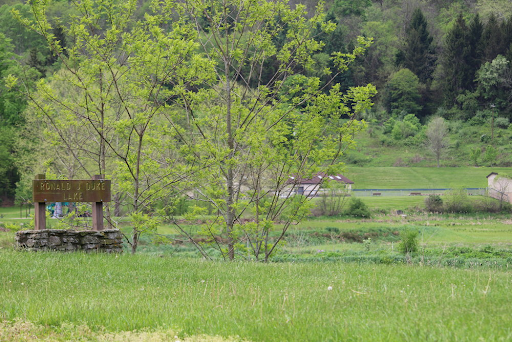
The area of Duke Lake in Ryerson Station State Park, after it was drained due to damage from underground coal mining.
In 1966, our state enacted a coal mining law known as the Bituminous Mine Subsidence and Land Conservation Act (BMSLCA). The law laid out several requirements and protections to make coal mining safe for both workers and community members. Due to overwhelming property damage resulting from room and pillar coal mining, the BMSLCA prohibited mine subsidence damage to existing homes and structures. As a result, the coal industry became more vigilant and developed more secure room and pillar mines in order to prevent such damage. However, in the late ’70s and early ’80s, mine operators introduced a higher extraction method called “longwall” mining to our state’s coalfields. The issue was that this more efficient extraction method conflicted with the BMSLCA’s prohibition of mine subsidence because with longwall mining comes planned and inevitable land subsidence. After numerous attempts to invalidate the 1966 BMSLCA, coal interests changed the law in 1996 with what is now known as Act 54.
Act 54 created a balancing act by allowing structural damage and water impairment by undermining, but only if they were repaired promptly. This duality allows for the legal extraction of coal, while also requiring the extractor to fix damages that occur on the surface to homes, water sources, etcetera. Under Act 54, the Department of Environmental Protection (DEP) was tasked with publishing a report every five years that looks at the number of impacts underground coal mining has had on structures, land, wildlife, streams, and drinking water supplies. The reports have provided the state and the public with details about how the coal mining industry has followed the promises that Act 54 makes. They show us the impacts that longwall mining has wrought on our communities: the acres of impacted land, the number of homes and other structures that have been damaged, the number of drinking water sources that have been affected, the number of streams that were damaged, and the number of mitigation efforts attempted or concluded. The reports also show that longwall mining is responsible for the majority of the damage done, compared to room and pillar.
Act 54 was finalized in 1994. In the 27 years since, there have been five reports detailing impacts to environmental and community resources. Underground mining technology has transformed, and operations have grown in size and impact. Simultaneously, the Commonwealth has witnessed significant environmental law advancements calling for more arduous protection of private and public resources from other extractive industries like natural gas.
Early last year, CCJ published a blog about the most recent Act 54 assessment done by researchers from the University of Pittsburgh and the Carnegie Museum of Natural History. The assessment is used to help the DEP in their effectiveness in carrying out, implementing, and changing the Act. In the blog, Community Organizer Nick Hood discussed the recent findings of the report, which seemed to indicate that the total number of impacted water supplies had dropped. However, the number of water supply liability cases resolved by company land purchases increased 46%. This is important, as many coal companies do not hold a duty to report damage incurred on their land. Something else the researchers highlighted was the overwhelming amount of land that the coal companies owned within Southwestern PA. This points directly to the misinterpretation above, that the number of water supplies impacted had dropped. However, the companies buy up swaths of impacted land and homes, then withhold information from the DEP that those properties were affected, and then the researchers report numbers that look like there has been a decrease in impacted water supplies. This is not actually the case. The number of reports simply decreased because they don’t report loss of water on land that they now own. Why would the company report its own wrongdoing if it isn’t necessary (because they bought the land), if they are not actually held to the requirements of reporting it, or if it will cost them money?
This latest report, along with the ones before it, show the multitude of ways that Act 54 is currently not providing adequate protection for community members to protect their homes and water supply. Even with the reported decrease in the number of water supplies being impacted, this report helps the reader to understand that there are other issues at play. It shows a deficiency in how the state manages the challenges associated with underground coal mining.
The Citizens Advisory Council to the DEP is currently accepting comments from the public on this latest assessment of the underground mining laws. It is imperative from the evidence shown in the 5th Act 54 Report that DEP needs to step into their authority to enforce timely mitigation efforts, require groundwater monitoring, and improve the mining program to protect residents’ properties and access to clean water.
It is time to speak to Act 54’s shortcomings.
To take action and voice your concerns about Act 54, click here.
